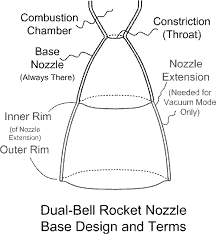THE ROCKY LAUNCH OF ROCKETS WITH BELL ENGINES
Rockets dish out ludicrous amounts of power. The lunar mission rockets, Saturn V’s first stage F1 engines, dished out an amazing 7.1 million pounds of thrust.
Although remarkable, powerful and useful, the Saturn V and essentially all modern-day rockets suffer from a big problem: Performance at altitude, meaning remaining efficient in flight. To put it bluntly, rockets today don’t remain efficient. In fact, they’re awful.
Current rockets use what’s called a bell-type engine, named for their shape. As the fuel quite literally explodes out of the bottom, the force of the explosion propels the rocket upward. But, this creates an issue. At high altitudes the plume expands, meaning the bell does not absorb as much pressure and the rocket will not have as much force pushing it. Not efficient, at all.

So, rockets use what’s called staging. Stages serve the dual purpose of cutting weight, as well as swapping engines for greater efficiency. The Saturn utilized three stages to go to the moon. Each stage used smaller and smaller engines to further concentrate the plume.
What then happens to these spent boosters? Well, if you’re SpaceX, your first stage will land itself, but the second is wasted. If you’re the Space Shuttle, you ditch your fuel tank and side boosters into the ocean. If you are the Saturn V or pretty much any rocket, you are entirely single use, meaning the boosters fly once and that is it.
All of this racks up a hefty price tag. Stages are wasted; rockets are wasted. Even with SpaceX’s reuse of the first stage, the company is still racking up million-dollar price tags. The Saturn V, adjusted for inflation, cost a jaw-dropping $1.23 billion per launch.
So, what can we do? Well, there is hope – with the Aerospike engine. It actually is a remarkably simple alternative to bell-shaped engines. To explain how it works, imagine an upside-down triangle. Now imagine standard rocket engines angled down, so they breathe fire onto the sides of this triangle. It seems like a useless addition at first, but trust me, this is revolutionary. This changes the force being absorbed into a spike, rather than a bell, so the spike takes the force from either side of the triangle and pushes the rocket up.
This engine eliminates the need for multiple engines, and to an extent, eliminates the need for staging. It does this by using altitude not as an enemy but as a friend. See, at low altitudes, the pressure of the atmosphere keeps the plume tight and performance high, which is necessary at launch. At high altitudes and space, it the pressure is low to nonexistent, and the plume expands, keeping the engine at maximum efficiency the whole flight.
This is one of the biggest of deals in rocketry history. This is an SSTO or Single Stage To Orbit engine, the proverbial holy grail of rockets. Why aren’t they more commonly used? Money. New companies such as SpaceX are profit-based, so dishing out millions to develop a flight-ready Aerospike might leach away profits in the long run.
NASA, a government agency, has been the driving force, moneywise, behind Aerospike engines as they exist today. They have actually been tested since the 1970s, again in the ’90s and in the early 2000s. The Space Shuttle replacement, the X-33, was actually going to have an SSTO Aerospike, but was ultimately canceled due to budget overruns unrelated to the engine.
Until we can greatly reduce launch costs, it doesn’t make sense to reinvent how we fly rockets. It makes more sense to stick with the safe bet until we have the spare money to continue to develop the future of spaceflight.
Meantime, we can wait and dream of a future where we can use rockets like planes, reduce costs and build futures and maybe one day vacation to the moon on the back of an Aerospike engine. We can all rest easy on the fact that the innovative spirit of space exploration never rests, and experts are constantly thinking of new ways to reinvent the wheel.

Leave a comment